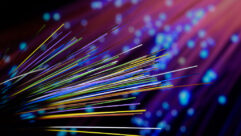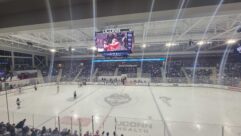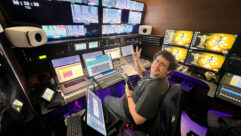Fiber Optics In the Home
Aug 1, 1999 12:00 PM,
Irwin Math
Fiber-optic technology is well known in telecommunications, local areanetworks, the CCTV security marketplace and in many IntelligentTransportation System (ITS) highway projects. Even CATV (cable)distribution to various local feed points within a residential community isnow routine for fiber. Where fiber has not made a major inroad, however, isin the region that encompasses the area directly to and within the averagehome. Here, CAT X copper wire cable still reins supreme. The increase indemand for bandwidth for a wide range of consumer-oriented services to comethat will fall within this region, however, could dramatically influencethe amount of fiber-optic cable used in residential applications.
Two of the most important attributes of fiber-optic cable that make it acandidate for wiring within the home are its inherent immunity toelectrical noise and the wide available bandwidth as compared to copperwire. Both of these features will be of great importance asconsumer-related high-speed technology develops. To achieve even a measureof these features for copper wire requires extensive shielding and carefulmanufacturing techniques to ensure uniform characteristics at highfrequencies along with low losses.
In the case of noise immunity, when installing fiber-optic cable in thehome, the contractor does not have to be particularly concerned with theexact route the cable will take; rather, he can install it via the mostconvenient path. Running a fiber cable in close proximity (or eventie-wrapped where electrical codes permit) to a power line will not resultin induced 60 Hz hum or other AC line interference nor create any situationwhere the integrity of the power line is compromised. Having a cableimmersed in a pool of water after a heavy rainstorm will not result inshort circuits or grounds, nor will it interfere with existing signalstraveling through the fiber. In addition, although a broken fiber-opticcable will result in a loss of signal, it will not create any electricalsafety or potential fire hazard.
The copper wire route, on the other hand, requires a separate path as farfrom a power line as possible. Even when this is done, the cable is stillsusceptible to short circuits and hum pickup, can create a safety hazardwhen broken, and requiresextensive equalization in the form of specialdrivers and receivers when increased bandwidth is required.
With regard to bandwidth, the hundreds of MHz per km available oninexpensive multimode fiber (or GHz per km for the similarly pricedsingle-mode version) will allow a multitude of live action HDTV cablechannels, ultra high-speed Internet access (in excess of T-1 data rates)and live full-motion video telephones to share a single optical conductorthat could, if desired, easily be routed from room to room. Because lighttravels in both directions within a fiber, even two-way communications areeasy. In fact, the only drawback to the use of fiber-optic technology todayis the electronic interfaces that are required (and their additional cost),but that will change as fiber-optic interfaces begin to appear on consumerproducts.
To convert electrical signals to and from light for transmission in afiber-optic system requires an optical transmitter and receiver. Thesedevices are similar to external computer modems in size, function andcomplexity and range in cost – a few hundred dollars for simple, singlechannel devices to several thousand dollars for a multiplexed, multi-signaldevice. Most of these take the form of small, self-contained modules thatcan be mounted anywhere convenient or in standard 19 inch (483 mm)rack-mountable card cages. Power is usually derived directly from the ACline or from small plug-in wall adapters. In a CCTV security system, forexample, an individual transmitter module would be mounted at each videocamera with all receivers mounted at a single monitoring location alongwith some sort of switch and monitor. In a high-end audio or videodistribution system within a home, a head-end would consist of a group oftransmitters at one location driving separate individual receivers in eachroom that signals were desired. Such a system could eliminate extraneousnoise pickup from various appliances around the house and could result insnow-free pictures coupled with noise-free CD-quality audio. Not only woulda room dedicated to a home entertainment center provide true movie theaterquality, but every room could, in essence, also become a mini-theater.
Today, common household A-V systems are normally interconnected by means ofcopper wire, both twisted-shielded pair and coaxial. The connections areeasily made with simple and inexpensive connectors or terminal blocks. Thevideo quality is not always perfect, and the sound is sometimes prone tointerference, but the results are acceptable. The equipment exists today,however, to do the job with fiber optics if one is not too concerned withcosts. An A-V transmitter/receiver set capable of transmitting andreceiving high-quality baseband video and line-level stereo audio pushesthe cost to $1,400. Remember, this is with existing equipment. In the nearfuture, it is not unreasonable to expect to have an optical port on avideodisc or CD player, especially when the signals to be distributed aredigitally encoded video and audio at data rates in the hundreds ofmegabits. When that occurs, prices will drop. It is important to realizethat even though installing a fiber-optic system using currently availabletransmission systems is more expensive than installing a copper wireinfrastructure in today’s home, as technology progresses, the electronictransmitters and receivers can always be upgraded. The fiber-optic cable inthe walls cannot be changed as easily, but because it is capable ofoperating in the GHz range, there is little risk of obsolescence.
As a result, the sound and video contractor of today would do well to learnabout fiber optics and how it will (and for that matter does) apply tofuture business. In fact, it is an even better idea to gain some hands-onexperience with such systems, even if it is just for a simple security link.










